Remuneration of Distribution Grids for Enhanced Regenerative Electricity Deployment—An Analysis and Model for the Analysis of Grid Structures in Southern Germany Using Linear Programming
Abstract
1. Introduction
- High-distance grids must be strengthened to transfer wind electricity produced in the northern seas to southern areas.
- Low-distance (distribution) grids must be remunerated to accept growing inputs of energy from local photovoltaic and wind energy production.
2. Previous Research in Clustering or Classification of Distribution Grids
- A first set of studies identifies feeders with remuneration requirements. Based on cluster analysis, DSOs with a low correspondence of requirements and infrastructural conditions are retrieved.
- A second set of studies proposes the optimization of network architecture by means of linear optimization algorithms to minimize investment and operation costs.
2.1. Clustering Algorithms to Identify Grid Remuneration Requirements
2.2. Linear Programming to Optimize Grid Architectures
2.3. Limitations of Previous Research
3. Grid Analysis in the Federal State of Baden-Württemberg
3.1. Selection of Region and Local Problem Set
- Regenerative electricity supply of any origin is scarce, intermittent, and too costly compared to European spot-market prices.
- Remote (offshore or foreign) regenerative electricity supply is limited due to limitations of grid infrastructure and transmission power losses.
3.2. Compilation and Evaluation of Grid Data
3.2.1. Future Scenarios for Power Inflow and Demand to the BW Grid
- (a)
- Present situation
- (b)
- Scenario in 2035
- (c)
- Scenario in 2050.
- a.
- An increase of grid load of 5% until 2035 and another 5% until 2050.
- b.
- A decrease of grid load of 5% until 2035 and another 5% until 2050.
- c.
- A decrease of decentral regenerative feed-in on the grid of 20% until 2035 and another 20% until 2050.
- d.
- Constant decentral regenerative feed-in on the grid in 2035 and 2050.
- e.
- An increase of the decentral regenerative feed-in on the grid of 20% until 2035 and another 20% until 2050.
3.2.2. Description of the Optimization Problem
- The optimal transportation amount from suppliers to to consumers … as a matrix and the total electricity deficit for Baden-Württemberg in each case, which must be imported.
- Distributions of the DSOs, which require a certain capacity on the grid. These required capacities are often located in a short range. This abets a local approach and thereby contributes to the aim of minimizing the needed amount of infrastructure (e.g., avoid the construction high-voltage lines, substations, and transformers).
- The necessary energy flows in between the regions are summarized visually in the form of maps illustrating the required main energy flows in between the areas. These are useful to assess which grid lines must be developed further. The energy flow charts are created for the 2050 scenario only, since this represents the target for grid transformation according to Gesetz zur Förderung des Klimaschutzes in Baden-Württemberg [63] in Baden-Württemberg.
4. Results
4.1. Necessary Electricity Imports from Outside Baden Württemberg for the Scenarios
4.2. Transportation Capacities for the Scenarios
4.3. Energy Flow Charts for the 2050 Scenarios
5. Conclusions
5.1. Summary of Results
- Independence from external supply will be reached by 2050 only if at the same time load on the grid is diminished while the feed-in of regenerative resources increases. However, if load on the grid increases while regenerative feed-ins remain constant or diminish, the dependence on external electricity resources will increase. In any case, a remuneration of the Baden-Württemberg grid infrastructure is useful to diminish dependency from external electricity inflows and in this way enhance supply security and diminish transmission losses and costs.
- The distribution of required grid capacities will change until 2035 and further until 2050 due to the reorganization of electricity supply toward significantly higher regenerative inflows. Until 2035, the capacity of small-scale grids will have to be increased due to the growing number of small-scale electricity producers feeding on the grid. Until 2050, this situation could change again since—given the present subsidy allocation—subsides will run out, and today, newly established small regenerative plants will age so that their number will decrease. Then, the supply will be covered by medium-sized providers and grids. Thus, Baden-Württemberg’s grid infrastructure will have to be continuously reorganized until 2050.
- Regenerative energy in Baden-Württemberg is produced in peripheral regions mainly, but energy consumption is focused in urban areas. The increase of regenerative inflows due to the EEG implies a remuneration of grids interconnecting peripheral and urban areas. With the phase-out of small regenerative plants from the grid, this infrastructure could turn obsolete, and Baden-Württemberg would depend on large transmission lines feeding in electricity from other German countries or other nations increasingly.
5.2. Policy Recommendations
- (a)
- Efficient, regenerative energy resources in the medium segment that are affordable even after the phase-out of government subsidies should be developed and step-by-step installed by medium-sized commercial operators and communities.
- (b)
- Small-scale regenerative energy producers, e.g., households and small communities, should be clearly informed on the profitability of their investments after the phase-out of the subsidy to avoid misallocations. Investing these funds in more efficient community projects could be more effective.
- (c)
- The federal government should invest in large-scale transmission grids and supply chain security to ensure regenerative energy supply for the Southern Federal Countries even after the end of the subsidy payments for regenerative plants and the closure of conventional power plants.
5.3. Limitations and Further Research Needs
Author Contributions
Funding
Conflicts of Interest
References
- IPCC. Klimaänderung 2013: Naturwissenschaftliche Grundlagen. Häufig Gestellte Fragen und Antworten—Teil des Beitrags der Arbeitsgruppe I zum Fünften Sachstandsbericht des Zwischenstaatlichen Ausschusses für Klimaänderungen (IPCC); Stocker, T.F., Qin, D., Plattner, G.-K., Tignor, M., Allen, S.K., Boschung, J., Nauels, A., Xia, Y., Bex, V., Midgley, P.M., Eds.; Deutsche Übersetzung Durch Die Deutsche IPCC-Koordinierungsstelle und Klimabüro für Polargebiete und Meeresspiegelanstieg: Bonn, Germany, 2017. [Google Scholar]
- UN. Climate Change. 2020. Available online: https://unfccc.int/ (accessed on 8 February 2020).
- BMWi (Bundesministerium für Wirtschaft und Energie). Was Bedeutet Sektorkopplung? Energiewende Direkt, 2020, Contribution of July 11, 2016. Available online: https://www.bmwi-energiewende.de/EWD/Redaktion/Newsletter/2016/14/Meldung/direkt-erklaert.html (accessed on 8 February 2020).
- Lpb Landeszentrale für Politische Bildung Baden Württemberg. Die Energiewende 2011. Available online: https://www.lpb-bw.de/energiewende (accessed on 8 February 2020).
- BMWi (Bundesministerium für Wirtschaft und Energie). Kabinett Beschließt Kohleausstiegsgesetz, Gemeinsame Pressemitteilung of Jan 29, 2020. Available online: https://www.bmwi.de/Redaktion/DE/Pressemitteilungen/2020/20200129-kabinett-beschliesst-kohleausstiegsgesetz.html (accessed on 8 February 2020).
- BMWi (Bundesministerium für Wirtschaft und Energie). Erneuerbare Energien. 2020. Available online: https://www.bmwi.de/Redaktion/DE/Dossier/erneuerbare-energien.html (accessed on 8 February 2020).
- Bundesnetzagentur. Stromnetz Zukunftssicher Gestalten. 2020. Available online: https://www.netzausbau.de/bedarfsermittlung/2022/archiv/de.html;jsessionid=D6CE223B06F56187A2AAEE74A3894EAE (accessed on 8 February 2020).
- Troester, E. New German grid codes for connecting PV systems to the medium voltage power grid. In 2nd International Workshop on Concentrating Photovoltaic Power Plants: Optical Design, Production, Grid Connection; 2009; pp. 1–4. Available online: https://www.google.com/url?sa=t&rct=j&q=&esrc=s&source=web&cd=&ved=2ahUKEwj576Gn17PsAhUQzqQKHU1zD5EQFjAAegQIAhAC&url=https%3A%2F%2Fwww.researchgate.net%2Ffile.PostFileLoader.html%3Fid%3D56fcd7b848954c26780b2de1%26assetKey%3DAS%3A345608402554880%401459410872390&usg=AOvVaw1L4I9zatibUcmn75zdN5aj (accessed on 14 September 2020).
- Netzentwicklungsplan Strom. Stromnetze. 2020. Available online: https://www.netzentwicklungsplan.de/de/wissen/stromnetze (accessed on 8 February 2020).
- TEnnet. Making the Connection, Integrated Annual Report 2014, Tennet Holding B.V. Available online: https://www.tennet.eu/fileadmin/user_upload/Company/Investor_Relations/Annual_Report/TenneT-AR14_UK.pdf (accessed on 8 February 2020).
- Ferreira, H.L.; Costescu, A.; L’Abbate, A.; Minnebo, P.; Fulli, G. Distributed generation and distribution market diversity in Europe. Energy Policy 2011, 39, 5561–5571. [Google Scholar] [CrossRef]
- Integrierter Geschäftsbericht 2016 Unsere Standorte. EnBW. 2016. Available online: https://www.enbw.com/integrierter-geschaeftsbericht-2016/ueberblick/unsere-standorte/ (accessed on 14 September 2020).
- Liste der Bestehenden Windkraftanlagen in Baden-Württemberg, Landesanstalt für Umwelt Baden-Württemberg, Daten und Kartendienst der LUBW. Available online: https://udo.lubw.baden-wuerttemberg.de/public/api/processingChain?ssid=805065c3-e98a-4d43-b3b7-c85cf0ee136e&selector=energie_wind.energie%3Aeebw_wind_best_anl.sel (accessed on 14 September 2020).
- Liste der Bestehenden Biomasseanlagen in Baden-Württemberg, Landesanstalt für Umwelt Baden-Württemberg, Daten und Kartendienst der LUBW. Available online: https://udo.lubw.baden-wuerttemberg.de/public/api/processingChain?ssid=2ea6b46c-172a-41ab-a594-0a4e577c9e10&selector=energie_biomasse.energie%3Aeebw_biomasse_holzfeuerung.sel (accessed on 14 September 2020).
- Liste der Bestehenden Freiland PV-Anlagen in Baden-Württemberg, Landesanstalt für Umwelt Baden-Württemberg, Daten und Kartendienst der LUBW. Available online: https://udo.lubw.baden-wuerttemberg.de/public/pages/map/default/index.xhtml?mapId=6e7b50a8-842a-436c-8bf2-a78201c5653f&overviewMapCollapsed=false&mapSrs=EPSG%3A25832&mapExtent=202379.18489065603%2C5240158%2C796026.815109344%2C5525631 (accessed on 14 September 2020).
- Erzeugung EnBW, Fossile Energien EnBW. 2020. Available online: https://www.enbw.com/unternehmen/konzern/energieerzeugung/fossile-energie/standorte.html (accessed on 14 September 2020).
- Erzeugung EnBW, Kernenergie EnBW. 2020. Available online: https://www.enbw.com/unternehmen/konzern/energieerzeugung/kernenergie/standorte.html (accessed on 14 September 2020).
- Erzeugung EnBW; Wasserkraft EnBW. 2020. Available online: https://www.enbw.com/erneuerbare-energien/wasser/standorte.html (accessed on 14 September 2020).
- Werkübersicht Großkraftwerk Mannheim, GKM. 2020. Available online: https://www.gkm.de/unternehmen/werkuebersicht/ (accessed on 14 September 2020).
- HKW Magierusstraße, FUG Fernwärme Ulm. 2020. Available online: https://www.fernwaerme-ulm.de/kraftwerke/hkw-magirusstrasse.html (accessed on 14 September 2020).
- Kriechbaum, L.; Scheiber, G.; Kienberger, T. Grid-based multi-energy systems—Modelling, assessment, open source modelling frameworks and challenges. BMC Energy Sustain. Soc. 2018. [Google Scholar] [CrossRef]
- Bundes Ministerium für Wirtschaft an Electricity Grid for the Energy Transition. Available online: https://www.bmwi.de/Redaktion/EN/Dossier/grids-grid-expansion.html (accessed on 14 October 2020).
- Broderick, R.J.; Williams, J.R. Clustering methodology for classifying distribution feeders. In Proceedings of the 2013 IEEE 39th Photovoltaic Specialists Conference (PVSC), Tampa, FL, USA, 16–21 June 2013; pp. 1706–1710. [Google Scholar]
- Nijhuis, M.; Gibescu, M.; Cobben, S. Clustering of Low Voltage Feeders form a Network Planning Perspective; CIRED: Belgium, UK, 2015. [Google Scholar]
- Rösch, T.; Treffinger, P. Cluster Analysis of Distribution Grids in Baden-Württemberg. Energies 2019, 12, 4016. [Google Scholar] [CrossRef]
- Bracale, A.; Caldon, R.; Celli, G.; Coppo, M.; Dal Canto, D.; Langella, R.; Scalari, S. Analysis of the Italian distribution system evolution through reference networks. In Proceedings of the 2012 3rd IEEE PES Innovative Smart Grid Technologies Europe (ISGT Europe), Berlin, Germany, 14–17 October 2012; pp. 1–8. [Google Scholar]
- Bletterie, B.; Kadam, S.; Renner, H. On the classification of low voltage feeders for network planning and hosting capacity studies. Energies 2018, 11, 651. [Google Scholar] [CrossRef]
- Míguez, E.; Cidrás, J.; Díaz-Dorado, E.; García-Dornelas, J.L. An Improved Branch-Exchange Algorithm for Large-Scale Distribution Network Planning. IEEE Trans. Power Syst. 2002, 17, 931. [Google Scholar] [CrossRef]
- Navarro, A.; Rudnick, H. Large-scale distribution planning—Part I: Simultaneous network and transformer optimization. IEEE Trans. Power Syst. 2009, 24, 744–751. [Google Scholar] [CrossRef]
- Lavorato, M.; Franco, J.F.; Rider, M.J.; Romero, R. Imposing radiality constraints in distribution system optimization problems. IEEE Trans. Power Syst. 2011, 27, 172–180. [Google Scholar] [CrossRef]
- Hong, Y.Y.; Ho, S.Y. Determination of network configuration considering multiobjective in distribution systems using genetic algorithms. IEEE Trans. Power Syst. 2005, 20, 1062–1069. [Google Scholar] [CrossRef]
- Ramirez-Rosado, I.J.; Bernal-Agustin, J.L. Genetic algorithms applied to the design of large power distribution systems. IEEE Trans. Power Syst. 1998, 13, 696–703. [Google Scholar] [CrossRef]
- Díaz-Dorado, E.; Pidre, J.C.; García, E.M. Planning of large rural low-voltage networks using evolution strategies. IEEE Trans. Power Syst. 2003, 18, 1594–1600. [Google Scholar] [CrossRef]
- Díaz-Dorado, E.; Pidre, J.C. Optimal planning of unbalanced networks using dynamic programming optimization. IEEE Trans. Power Syst. 2004, 19, 2077–2085. [Google Scholar] [CrossRef]
- Cruz, M.R.; Fitiwi, D.Z.; Santos, S.F.; Catalão, J.P. Flexibilizing Distribution Network Systems via Dynamic Reconfiguration to Support Large-Scale Integration of Variable Energy Sources Using a Genetic Algorithm. In Doctoral Conference on Computing, Electrical and Industrial Systems; Springer: Cham, Germany, 2017; pp. 72–80. [Google Scholar]
- Scheidler, A.; Thurner, L.; Braun, M. Heuristic optimisation for automated distribution system planning in network integration studies. IET Renew. Power Gener. 2018, 12, 530–538. [Google Scholar] [CrossRef]
- Azizivahed, A.; Arefi, A.; Ghavidel, S.; Shafie-khah, M.; Li, L.; Zhang, J.; Catalão, J.P. Energy management strategy in dynamic distribution network reconfiguration considering renewable energy resources and storage. IEEE Trans. Sustain. Energy 2019, 11, 662–673. [Google Scholar] [CrossRef]
- Gupta, A.; Thakur, R. Review on Radial distribution Network BY Dg Planning Using Optimization Approaches. Tathapi ISSN 2320-0693 UGC CARE J. 2020, 19, 1–7. [Google Scholar]
- Zidan, A.; Shaaban, M.F.; El-Saadany, E.F. Long-term multi-objective distribution network planning by DG allocation and feeders’ reconfiguration. Electr. Power Syst. Res. 2013, 105, 95–104. [Google Scholar] [CrossRef]
- EnBW Kernkraft. 2020. Available online: https://www.enbw.com/unternehmen/konzern/energieerzeugung/kernenergie/ (accessed on 1 April 2020).
- Die Bundesregierung Der Einstieg in den Kohleausstieg, Abschussbericht der Kohlekommission. 2019. Available online: https://www.bundesregierung.de/breg-de/aktuelles/der-einstieg-in-den-kohleausstieg-1574264 (accessed on 1 April 2020).
- Statistisches Landesamt Baden-Württemberg. 28% des Erzeugten Stroms aus Erneuerbaren Energien Baden-Württemberg: Mehr Strom aus Kernenergie und Windkraft, Rückgänge bei Erdgas und Wasserkraft/2019. Available online: https://www.statistik-bw.de/Presse/Pressemitteilungen/2019314 (accessed on 1 April 2020).
- Agentur für Erneuerbare Energien Anteil Erneuerbarer Energien am Bruttostromverbrauch. 2020. Available online: https://www.foederal-erneuerbar.de/landesinfo/bundesland/BW/kategorie/strom/auswahl/772-anteil_erneuerbarer_/#goto_772 (accessed on 1 April 2020).
- Ministerium für Umwelt, Klima und Energiewirtschaft Baden-Württemberg. Available online: https://um.baden-wuerttemberg.de/de/energie/erneuerbare-energien/windenergie/ (accessed on 1 April 2020).
- Goetz, U. Das Dilemma der Grünen beim Klimaschutz, Deutschlandfunk Kultur, Beitrag vom 12.11.2019. 2019. Available online: https://www.deutschlandfunkkultur.de/windkraft-in-baden-wuerttemberg-das-dilemma-der-gruenen.1001.de.html?dram:article_id=463284 (accessed on 1 April 2020).
- TenneT 2020. Offshore Porjekte Deutschland. Available online: https://www.tennet.eu/index.php?id=2130&L=2 (accessed on 1 April 2020).
- Bundesministerium für Wirtschaft und Energie, Netzanbindung. Available online: https://www.erneuerbare-energien.de/EE/Navigation/DE/Technologien/Windenergie-auf-See/Technik/Netzanbindung/netzanbindung.html (accessed on 1 April 2020).
- Mehlhorn, K.; Liemt, J. Bestimmung der Elektrischen Verluste im NETZ Eines Städtischen Netzbetreibers. ew Magazin für Energiewirtschaft 2004, Jg 103, Heft 1-2, 20–23. [Google Scholar]
- EEG (Gesetz für den Ausbau Erneuerbarer Energien (ErneuerbareEnergien-Gesetz—EEG 2017), § 20. Available online: https://www.gesetze-im-internet.de/eeg_2014/EEG_2017.pdf (accessed on 14 April 2020).
- Eurostat 2020. Electricty Price Statistics. Available online: https://ec.europa.eu/eurostat/statistics-explained/index.php/Electricity_price_statistics#Electricity_prices_for_non-household_consumers (accessed on 14 April 2020).
- Hau, E. Windkraftanlagen—Grundlagen, Technik, Einsatz, Wirtschaftlichkeit, 5th ed.; Springer: Berlin/Heidelberg, Germany, 2014; p. 86. [Google Scholar]
- Witsch, K.; Stratmann, K. Ausbau der Windkraft Bricht Dramtisch ein, Handelsblatt, Contribution of July 25, 2019. Available online: https://www.handelsblatt.com/unternehmen/energie/erneuerbare-energien-ausbau-der-windkraft-bricht-dramatisch-ein/24696524.html?ticket=ST-4348315-ey9fJI0fkupmYQap64KM-ap1 (accessed on 14 April 2020).
- Forsa. Stimmungsbild Windkraft in Brandenburg, Ergebnisbericht, Study for EnBW. 2018. Available online: https://www.enbw.com/erneuerbare-energien/windenergie/unsere-windparks-an-land/bau-und-planung.html (accessed on 1 April 2020).
- Ministerium für Umwelt, Klima und Energiewirtschaft Baden-Württemberg, Klimaschutzgesetz Baden-Württemberg. Available online: https://um.baden-wuerttemberg.de/de/klima/klimaschutz-in-baden-wuerttemberg/klimaschutzgesetz/#:~:text=Gesetz%20zur%20F%C3%B6rderung%20des%20Klimaschutzes%20in%20Baden%2DW%C3%BCrttemberg&text=Es%20ist%20am%2031.%20Juli%202013%20in%20Kraft%20getreten.&text=Des%20Weiteren%20sieht%20das%20Gesetz,landesweiten%20Anpassungsstrategie%20zu%20begrenzen%20sind (accessed on 5 July 2020).
- Ministerium für Umwelt, Klima und Energiewirtschaft Baden-Württemberg 2020. Monitoring der Energiewende in Baden-Württemberg, Statusbericht 2019. Available online: https://um.baden-wuerttemberg.de/fileadmin/MinisteriumfürUmwelt,KlimaundEnergiewirtschaftBaden-Württemberg (accessed on 1 October 2020).
- Monitoring der Energiewende in Baden-Württemberg, Statusbericht 2019. Available online: https://um.baden-wuerttemberg.de/fileadmin/redaktion/m-um/intern/Dateien/Dokumente/2_Presse_und_Service/Publikationen/Energie/Monitoring-der-Energiewende-2019.pdf (accessed on 5 July 2020).
- Deutsche Bundesregierung. Klimaschutzprogramm 2030 der Bundesregierung zur Umsetzung des Klimaschutzplans 2050. 2020. Available online: https://www.bundesregierung.de/resource/blob/975226/1679914/e01d6bd855f09bf05cf7498e06d0a3ff/2019-10-09-klima-massnahmen-data.pdf?download=1 (accessed on 5 July 2020).
- Deutsche Bundesregierung. Stellungnahme Zum Zweiten Monitoring-Bericht der Bundesregierung für das Berichtsjahr 2012. 2012. Available online: https://www.bmwi.de/Redaktion/DE/Downloads/M-O/monitoringbericht-energie-der-zukunft-stellungnahme.pdf?__blob=publicationFile&v=3 (accessed on 5 July 2020).
- Ministerium für Umwelt, Klima und Energiewirtschaft Baden-Württemberg. 2020. Energieeffizienz. Available online: https://um.baden-wuerttemberg.de/de/energie/energieeffizienz/ (accessed on 5 July 2020).
- Ministerium für Umwelt, Klima und Energiewirtschaft Baden-Württemberg. 2020. Erneuerbare Energien. Available online: https://um.baden-wuerttemberg.de/de/energie/erneuerbare-energien// (accessed on 5 July 2020).
- Ministerium für Umwelt, Klima und Energiewirtschaft Baden-Württemberg. 2020. Zuverlässige und Stabile Energieversorgung. Available online: https://um.baden-wuerttemberg.de/de/energie/versorgungssicherheit/ (accessed on 5 July 2020).
- Regelungen aus der Messwesen Strom (Metering Code) VDE-Anwendungsregel AR 4400; VDE Verlag: Munich, Germany, 2019.
- Gesetz zur Förderung des Klimaschutzes in Baden-Württemberg. 2013. Landtag von Baden -Württemberg, Gesetzesbeschluss des Landtages, Drucksache 15/3842. Available online: https://um.baden-wuerttemberg.de/fileadmin/redaktion/m-um/intern/Dateien/Dokumente/4_Klima/Klimaschutz/Klimaschutzgesetz/Gesetzesbeschluss_Klimaschutzgesetz.pdf (accessed on 22 April 2020).
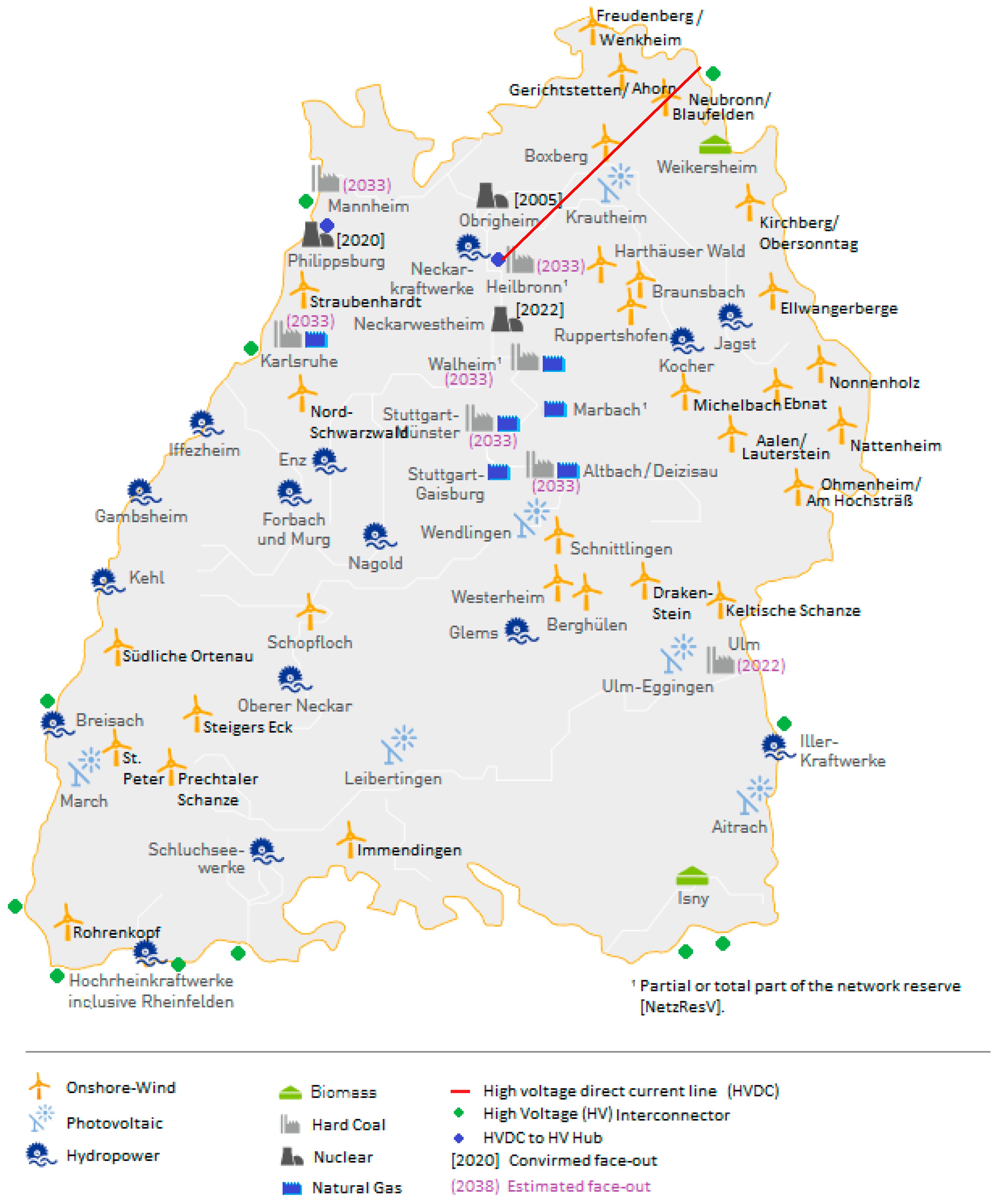

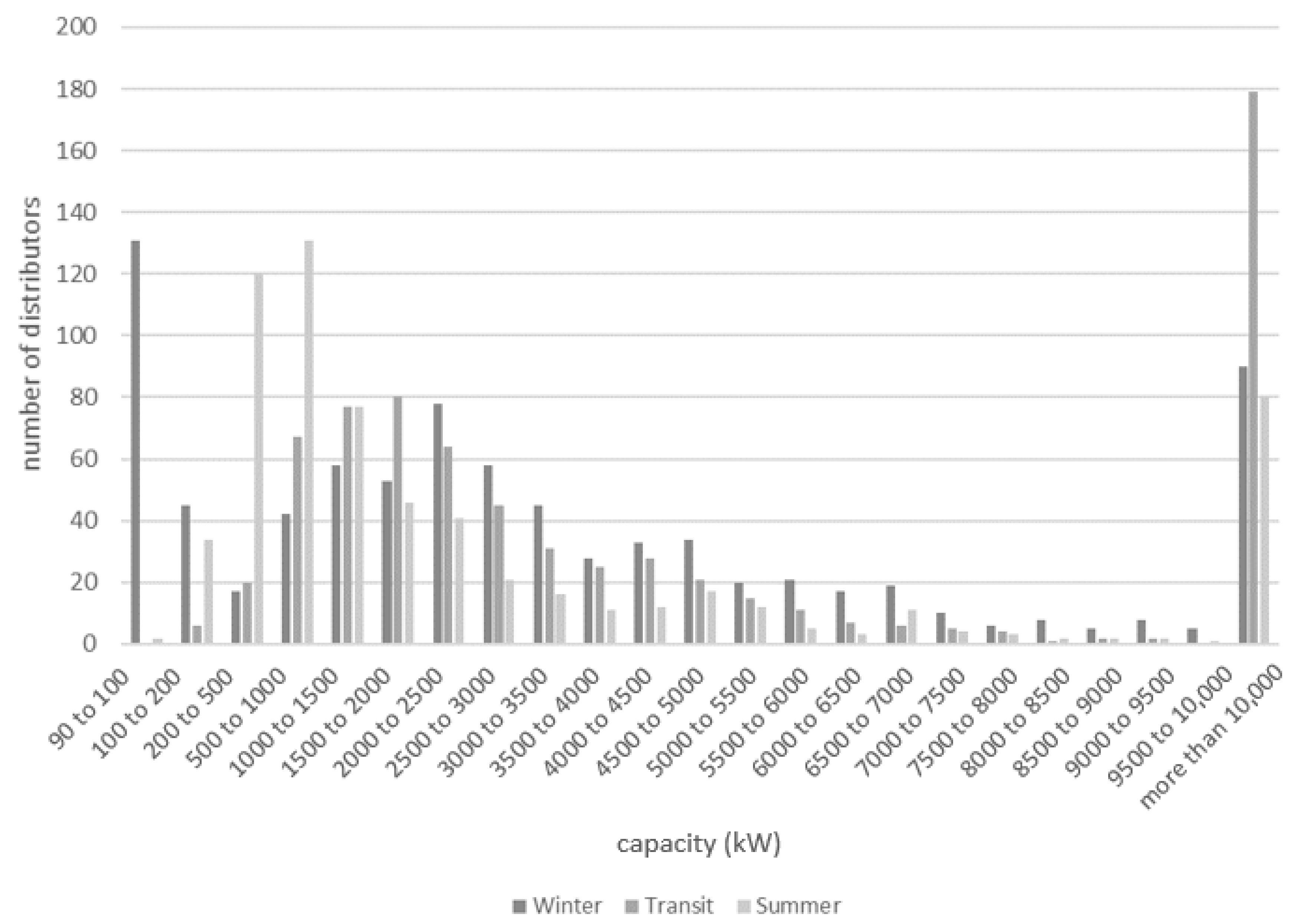
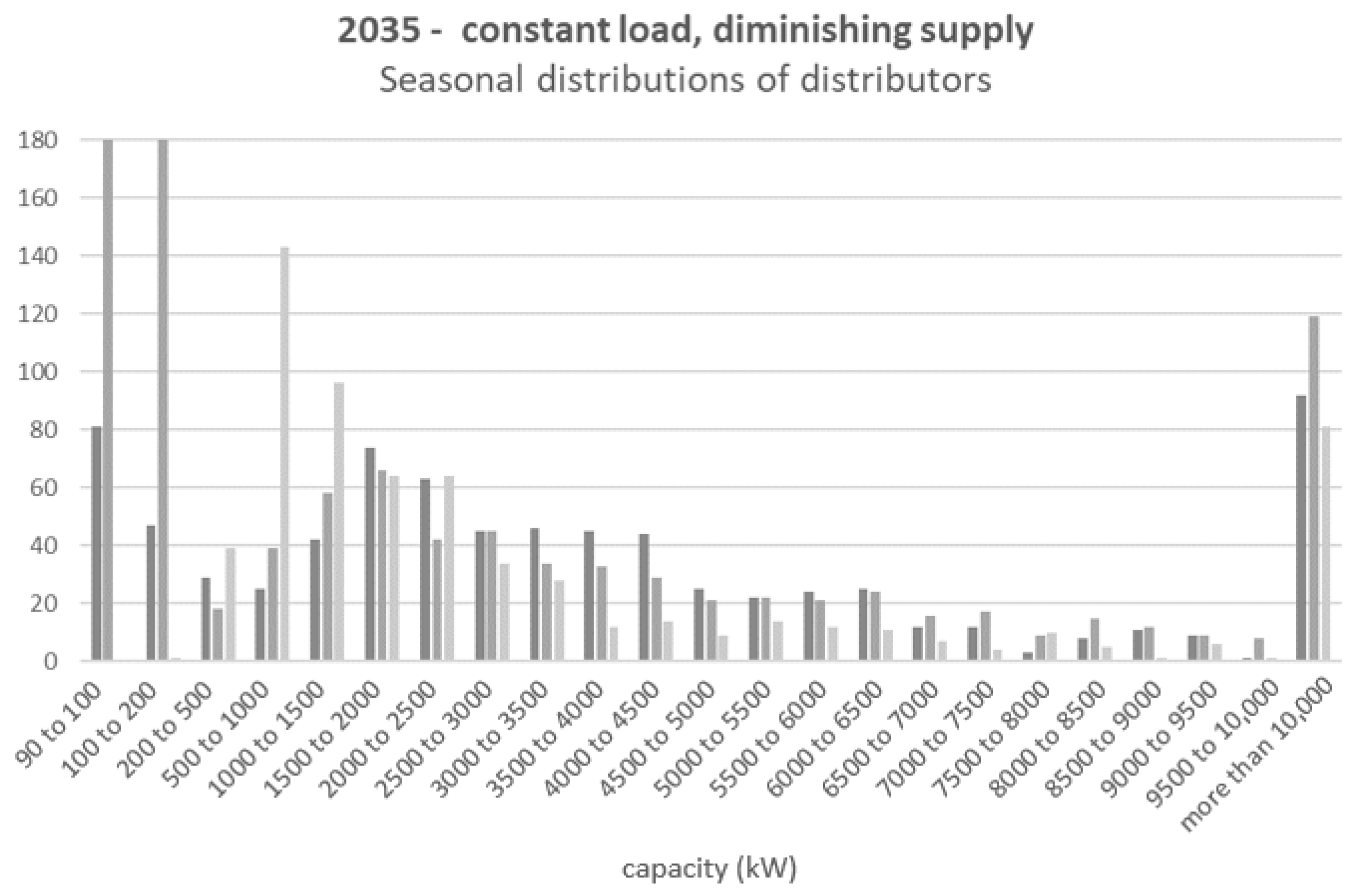

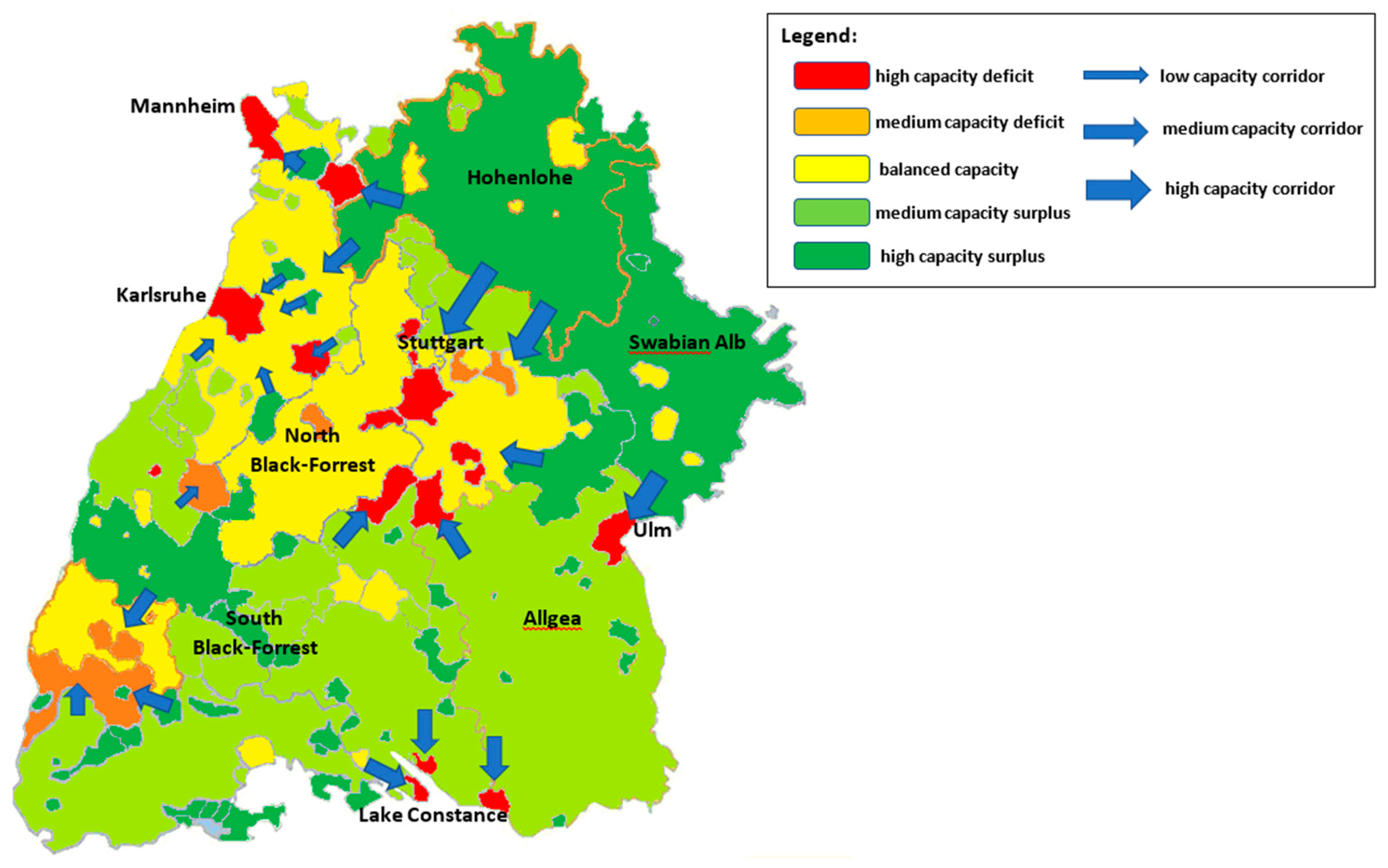
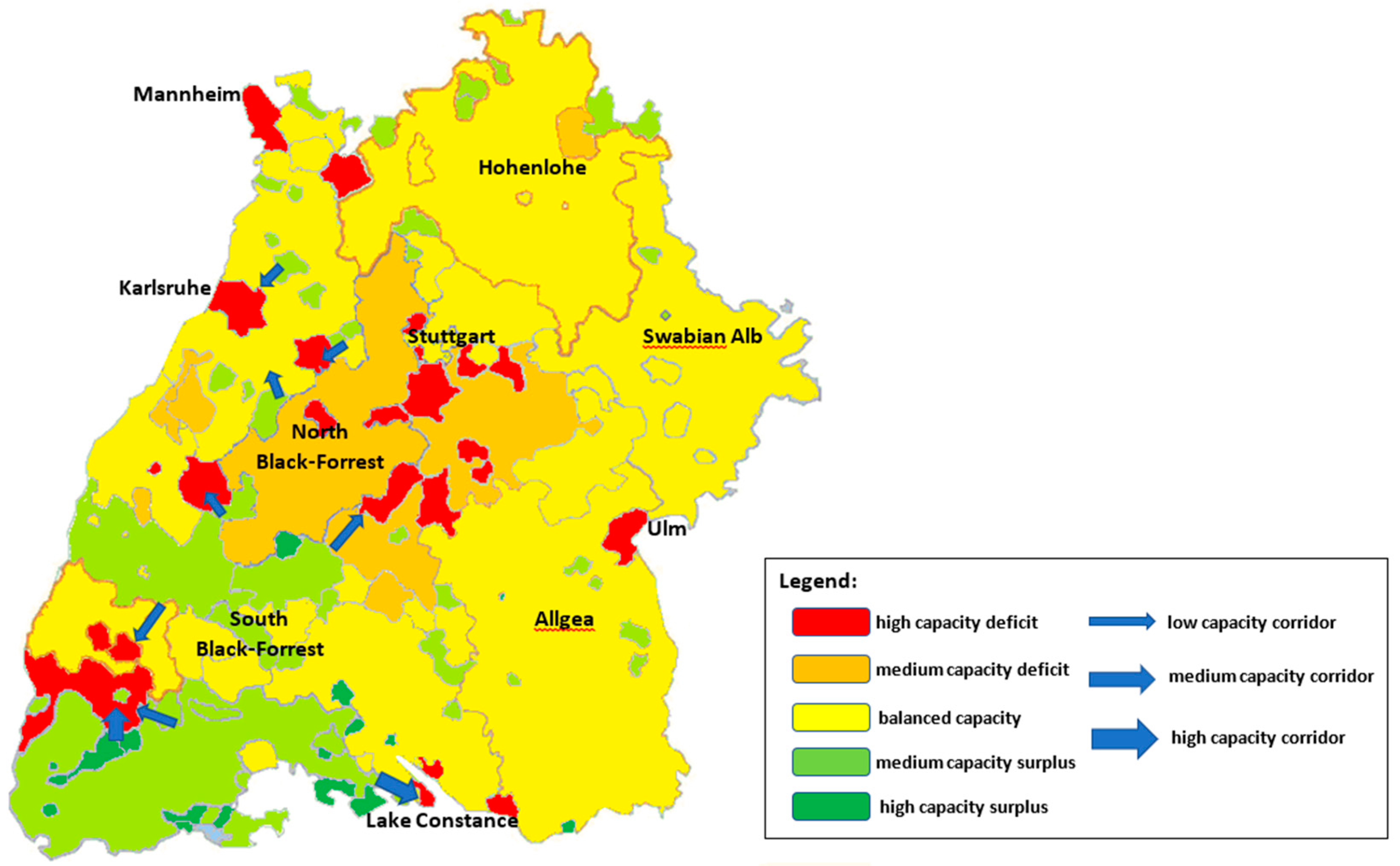
| Clustering Algorithms to Identify Grid Remuneration Requirements | |||
|---|---|---|---|
| Year | Concept | Data | Objective |
| 2013 Broderick and Williams | Clustering of Californian feeders By k-means algorithm | Voltage Type and number of phases Served customers | Remuneration of grid architecture for PV inflows |
| 2015 Nijhuis et al. | Clustering of Dutch feeders using k-means algorithm | Cable length Number of branches Brand depth Number and type of customers | Identification of feeders with high default risk |
| 2015 Bracale et al. | Descriptive statistics for Italy | Development status in Italy and other countries | Development scenarios for Italy under increasing regenerative resource inputs |
| 2019 Bletterie et al. | Austrian feeders, clustering with k-means | Sum impedance Maximum/average inflow, cable length/load | Classify DSO for regenerative hosting capacity |
| 2019 Rösch and Treffinger | Clustering of Baden-Württemberg DSO by k-means and Gauss-Newton | Demographic requirements Grid construction status | Remuneration of DSO for expanding regenerative energy inflow |
| Linear Programming to Optimize Grid Architectures | ||||
|---|---|---|---|---|
| Year | Situation | Input | Controls | Target |
| 2003 Miguez et al. | Greenfield model optimal grid design | Location Costs Fixed demand | Minimum supply Number of outages voltage drop | Minimize investment and operation costs |
| 2009 Navarro and Rudnick | Greenfield transformer station design, rural Chile | Costs Street arrangement Fixed demand | Transformer capacity | Minimize investment and operation costs |
| 2014 Navarro | Conductor capacity design for residential consumers in UK | Consumed loads as a timeline Load shifting effects | Voltage drop Power loss Conductor capacity | Minimize conductor costs |
| 2003 Díaz-Dorado et al. | Existing rural medium and low-voltage networks | Location Costs Voltage Deterministic demand | Conductor capacity Voltage drop Power loss | Minimize investment, maintenance and operation costs |
| 2004 Díaz-Dorado et al. | Existing rural low-voltage networks with single and three-phase consumers | Consumer type Costs Voltage Deterministic demand per consumer | Conductor type Papering Power loss in lines Capacities Voltage drop | Minimize investment, maintenance and operation costs |
| 2012 Lavorato et al. | Greenfield planning of distribution grid | Radiality of grid Total number of nodes Distributed generation | Minimize energy losses on grid | |
| 2013 Zidan et al. | Grid remuneration in Ontario Canada | Gas/PV/wind Intermittent regenerative inflows Mixed consumers | Max. grid load Power factor = 0.95 Bus interconnection restrictions | Minimize total including remuneration costs Minimize gas emissions |
| 2016 Scheidler et al. | Automated distribution system planning approach for network reconfiguration | Feeder lengths of small agglomerations | Voltage constraint | Reduction of feeder length to reduce transportation losses Expected cost of grid remuneration |
| 2017 Cruz et al. | Distribution grid remuneration | Energy supplied and retrieved Admission of suppliers and consumers to the grid | Production costs Radial closed network | Minimize losses Minimize costs of operation |
| 2019 Azizvahed et al. | Distribution grid reconfiguration in dynamic model | Energy supplied and retrieved | Balance and unbalanced distribution grids State of health constraint | Voltage stability index Minimize non supplied energy Grid lifetime prolongation |
| 2020 Gupta et al. | Review of studies in distribution grid optimizations | Dispersed generators Deregulated environment | Costs Technical constraints | |
| Future Scenarios | ||
|---|---|---|
| Basis | 2035 | 2050 |
| Load | +5% | +5% |
| −5% | −5% | |
| 0% | 0% | |
| Feed-in | +20% | +20% |
| −20% | −20% | |
| 0% | 0% | |
| E | Absolute energy inflow into Baden-Württemberg |
| Ap | Degree of autonomy of Baden-Württemberg |
| GoIp | Degree of meshing of the different scenarios |
| RCt | Relation of large distance connections to total connections |
| In MW | 2035 | 2050 | |||||
|---|---|---|---|---|---|---|---|
| Basic 2020 | 337.87 | 370.83 | 497.62 | 337.87 | 370.83 | 497.62 | |
| Load | Feed-in | Summer | Transit | Winter | Summer | Transit | Winter |
| + | − | 381.88 | 469.44 | 508.68 | 391.07 | 479.92 | 519.74 |
| + | c | 354.47 | 351.57 | 521.47 | 219.53 | 332.94 | 547.64 |
| + | + | 274.52 | 294.70 | 445.33 | 218.87 | 227.76 | 399.77 |
| − | − | 363.56 | 352.00 | 473.49 | 360.32 | 334.68 | 463.99 |
| − | c | 322.15 | 284.23 | 313.23 | 66.37 | 109.50 | 128.84 |
| − | + | 111.87 | 109.14 | 249.51 | 0 | 0 | 0 |
| Change on 2020 in% | 2035 | 2050 | |||||
|---|---|---|---|---|---|---|---|
| Basic 2020 | 0% | 0% | 0% | 0% | 0% | 0% | |
| Load | Feed-in | Summer | Transit | Winter | Summer | Transit | Winter |
| + | − | 13.0% | 26.6% | 2.2% | 15.7% | 29.4% | 4.4% |
| + | c | 4.9% | −5.2% | 4.8% | −35.0% | −10.2% | 10.1% |
| + | + | −18.7% | −20.5% | −10.5% | −35.2% | −38.6% | −19.7% |
| − | − | 7.6% | −5.1% | −4.8% | 6.6% | −9.7% | −6.8% |
| − | c | −4.7% | −23.4% | −37.1% | −80.4% | −70.5% | −74.1% |
| − | + | −66.9% | −70.6% | −49.9% | −100.0% | −100.0% | −100.0% |
| Rate of Autonomy% | Summer | Winter | Transit | ||||
|---|---|---|---|---|---|---|---|
| Basic 2020 | 44.85% | 46.94% | 32.53% | ||||
| 2035 | 2050 | ||||||
| Load | Feed-In | Summer | Transit | Winter | Summer | Transit | Winter |
| + | − | 38.59% | 33.82% | 32.05% | 38.03% | 33.31% | 31.58% |
| + | c | 42.21% | 40.77% | 43.37% | 78.31% | 68.66% | 65.06% |
| + | + | 55.85% | 58.45% | 40.51% | 65.32% | 68.36% | 47.37% |
| − | − | 48.45% | 45.34% | 42.42% | 52.86% | 56.06% | 49.88% |
| − | c | 54.01% | 62.85% | 45.51% | 76.46% | 62.01% | 68.41% |
| − | + | 75.63% | 79.16% | 54.86% | 100% | 100% | 100% |
| Grade of Interconnectedness | Summer | Transit | Winter | ||||
|---|---|---|---|---|---|---|---|
| Basic 2020 | 4.9% | 5.2% | 6.2% | ||||
| 2035 | 2050 | ||||||
| Load | Feed-In | Summer | Transit | Winter | Summer | Transit | Winter |
| + | − | 4.9% | 9.2% | 5.9% | 4.9% | 5.0% | 5.0% |
| + | c | 8.2% | 6.2% | 6.0% | 6.7% | 5.3% | 7.3% |
| + | + | 5.2% | 5.3% | 5.0% | 9.4% | 8.9% | 8.8% |
| − | − | 5.7% | 5.9% | 5.8% | 5.6% | 5.8% | 8.2% |
| − | c | 8.0% | 5.0% | 5.0% | 6.8% | 6.4% | 8.2% |
| − | + | 9.4% | 9.3% | 8.8% | 18.0% | 16.6% | 17.4% |
| Number of Connections | Summer | Transit | Winter | ||||
|---|---|---|---|---|---|---|---|
| Basic 2020 | 653 | 696 | 831 | ||||
| 2035 | 2050 | ||||||
| Load | Feed-In | Summer | Transit | Winter | Summer | Transit | Winter |
| + | − | 656 | 1217 | 785 | 657 | 662 | 659 |
| + | c | 1085 | 821 | 791 | 891 | 709 | 972 |
| + | + | 686 | 705 | 664 | 1248 | 1187 | 1173 |
| − | − | 753 | 784 | 771 | 746 | 772 | 1082 |
| − | c | 1062 | 661 | 657 | 906 | 844 | 1093 |
| − | + | 1244 | 1229 | 1160 | 2390 | 2220 | 2306 |
| Number of Long-Distance Connections | Summer | Transit | Winter | ||||
|---|---|---|---|---|---|---|---|
| Basic 2020 | 228 | 195 | 233 | ||||
| 2035 | 2050 | ||||||
| Load | Feed-In | Summer | Transit | Winter | Summer | Transit | Winter |
| + | − | 230 | 231 | 235 | 231 | 234 | 234 |
| + | c | 228 | 209 | 219 | 167 | 210 | 222 |
| + | + | 207 | 206 | 233 | 180 | 182 | 214 |
| − | − | 230 | 209 | 226 | 230 | 210 | 233 |
| − | c | 210 | 234 | 233 | 167 | 177 | 177 |
| − | + | 181 | 180 | 179 | 199 | 188 | 192 |
| Ratio of Long to Total Connections | Summer | Transit | Winter | ||||
|---|---|---|---|---|---|---|---|
| Basic 2020 | 35.0% | 28.0% | 28.0% | ||||
| 2035 | 2050 | ||||||
| Load | Feed-In | Summer | Transit | Winter | Summer | Transit | Winter |
| + | − | 35.1% | 19.0% | 29.9% | 35.1% | 35.3% | 35.5% |
| + | c | 21.0% | 25.5% | 27.7% | 18.7% | 29.6% | 22.8% |
| + | + | 30.0% | 29.2% | 35.1% | 14.4% | 15.3% | 18.2% |
| − | − | 30.5% | 26.7% | 29.3% | 30.8% | 27.2% | 21.3% |
| − | c | 19.8% | 35.4% | 35.5% | 18.4% | 20.9% | 16.2% |
| − | + | 14.5% | 14.6% | 15.4% | 8.3% | 8.4% | 8.3% |
Publisher’s Note: MDPI stays neutral with regard to jurisdictional claims in published maps and institutional affiliations. |
© 2020 by the authors. Licensee MDPI, Basel, Switzerland. This article is an open access article distributed under the terms and conditions of the Creative Commons Attribution (CC BY) license (http://creativecommons.org/licenses/by/4.0/).
Share and Cite
Rösch, T.; Treffinger, P.; Koch, B. Remuneration of Distribution Grids for Enhanced Regenerative Electricity Deployment—An Analysis and Model for the Analysis of Grid Structures in Southern Germany Using Linear Programming. Energies 2020, 13, 5385. https://doi.org/10.3390/en13205385
Rösch T, Treffinger P, Koch B. Remuneration of Distribution Grids for Enhanced Regenerative Electricity Deployment—An Analysis and Model for the Analysis of Grid Structures in Southern Germany Using Linear Programming. Energies. 2020; 13(20):5385. https://doi.org/10.3390/en13205385
Chicago/Turabian StyleRösch, Tobias, Peter Treffinger, and Barbara Koch. 2020. "Remuneration of Distribution Grids for Enhanced Regenerative Electricity Deployment—An Analysis and Model for the Analysis of Grid Structures in Southern Germany Using Linear Programming" Energies 13, no. 20: 5385. https://doi.org/10.3390/en13205385
APA StyleRösch, T., Treffinger, P., & Koch, B. (2020). Remuneration of Distribution Grids for Enhanced Regenerative Electricity Deployment—An Analysis and Model for the Analysis of Grid Structures in Southern Germany Using Linear Programming. Energies, 13(20), 5385. https://doi.org/10.3390/en13205385




